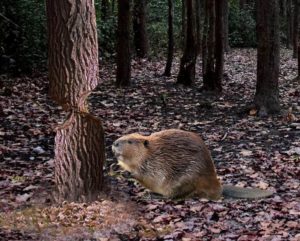
There are two living species of beavers, the Eurasian, Castor fiber and the North Americans, Castor canadensis. Beavers belong to the mammalian family Castoridae of Rodentia that evolved in the Oligocene epoch but the genus Castor evolved much later in the Pleistocene, about 2 million years ago.
The two living species are genetically different and have a different number of chromosomes (48 in the European and 40 in the North American species). The two species are also not known to hybridize and produce viable offspring. Beavers are famous for building large dams across rivers in northern Canada by falling large trees, an amazing feat for a small animal.
Beavers are the only animals, other than human beings, which alter their environment and surrounding habitat to suit them and their families. Beavers mate for life and reproduce once a year, but their kits stay with the family for two years, after which they may seek mates and build their own dams.
Food
Beavers feed on leaves, twigs, stems and bark of a variety of plants, such as, alder (Alnus sp.), aspen (Populus tremuloides), birch (Betula sp.), cottonwood (Populus trichocarpa), maple (Acer sp. ), poplar (Populus sp.) and willow (Salix sp.). In the summer months they feed on the tubers and leaves of cattails, water lilies, sedges and other pond weeds. Occasionally conifers, such as pine and fir are also eaten. Beavers are herbivores and never eat fish or other carnivorous diets. To digest cellulose, they have symbiotic bacteria in their intestines that produce the cellulose-digesting enzyme cellulase.
Morphological adaptations
Adult beavers are 3-4 feet long and weigh 15-30 kg. In the Pleistocene epoch there were giant beavers inhabiting Europe and North America which were almost the size of a black bear. They were wiped out along with other large mammals in the Pleistocene mass extinction.
Beavers are excellent swimmers and well adapted for amphibious mode of life and for building dams. They possess a large flattened paddle-like tail to propel them in water. The tail may measure 15 inches long and 6 inches wide, covered with leathery scales and sparse, coarse hairs. The hind legs are larger and stronger with webbed feet to give them strong propulsion while carrying branches through water to build dams. Front legs are smaller and feet without web to manipulate wood and dig canals in the banks of ponds.
The skin is protected with a double layer of dense fur, coated with oil secreted by a pair of oil glands, so that water does not reach the skin even when submerged in water. In addition to fur a thick layer of subcutaneous fat protects them from freezing cold in winter months.
As in other rodents, the front incisors of beavers are enlarged, chisel-shaped and self-sharpening, as only the front side is covered by hard enamel. The softer posterior dentine layer of incisors wears out quickly while the anterior hard enamel remains longer to keep it razor sharp to cut wood easily. Having this amazingly effective implement at their disposal, beavers cut a deep groove around the trunk of a tree, making the tree fall easily.
Dam construction
Beavers are adapted to live in stagnant water of ponds and lakes and hence they construct dams to stop running water of a river, so that a pool is formed behind the dam, in the middle of which they build an island of branches and twigs to make a nest or lodge. This lodge in the middle of the pond protects them and their offspring from predators.
There can be 2-12 individuals of a single family living in a lodge. Beavers’ feat of dam construction is remarkable because some of these dams are hundreds of meters or more across the river and are made of branches of trees brought from the forest. The largest recorded beaver dam measured 850 m long in northern Alberta, Canada.
The lodge or nest in the middle of this island can be reached only through underwater passages and hence is out of reach of terrestrial predators. The walls of the lodge are built with sticks and sealed with mud to keep them warm in the winter months. Beavers do not hibernate and need food in winter. Therefore, they store branches of edible plants in the dam, which can be easily reached from the nest.
When they are living in stagnant water of ponds and lakes, beavers excavate tunnels and caverns into the banks and make protective nests inside.
Beavers are also economically important to humans as the wetlands created behind the dams soak up floodwaters, reduce soil erosion, raise water tables and purify water by silting. Polluting pesticides are broken down into harmless chemicals by microbes in the wetlands created by beavers. The wetland habitat created by beavers is essential for many species of plants and other wildlife, such as frogs, insects, snails, fishes, migratory water birds, ducks, geese, raccoons etc. Beavers produce an ecosystem that is very rich in life.
